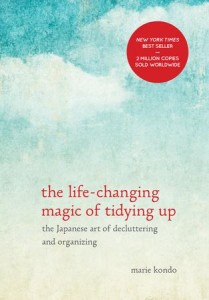
Marie Kondo is a Japanese organizing consultant, a job that I didn’t know existed. She teaches people how to organize their houses and cabinets in Japan. Initially, I questioned why I purchased a book on tidying your house. It seemed like a waste of time to read 200 pages on something so simple, thinking a book on such a simple subject wouldn’t teach me much. However, I was wrong. It turned out to be a great exercise in letting go and diving deeper in why we want to keep things.
I like how Marie desconstructed the purpose of items like photographs, gifts, books and papers in your house one by one and explained their reason for existence and why you can get rid of them. The part about organizing books was the most enlightening part for me:
- Read books: You’re inclined to keep them thinking you might want to read them again. The reality is, you are going to read very few of your books again. You can get rid of them
- Unread / half read books: You keep these thinking you might read them sometime. The author claims, “this is your chance to let it go. The book’s purpose was to teach you that you didn’t need it. There’s no need to finish reading books that you only got halfway through. It will be far better for you to read the book that really grabs you right now.” So get rid of all those unread books. “The moment you first encounter a particular book is the right time to read it. To avoid missing that moment, I recommend that you keep your collection small.”
There were other techniques listed in the book that could be applied to different areas in your life:
- The first step is to visualize what the inside of your drawer will look like when you finish.
- Don’t tidy up incrementally, tidy up in one go. Don’t tidy up by location (living room, bedroom etc.), instead tidy up by category (like all clothes, all books etc.)
- The most important part of the book is giving you a framework for deciding on what to keep and what to throw away. The criteria is, “does it spark joy?” If it does, keep it, if not, dispose of it.
There’s a good mix of philisophical and practical matters in the book as well. The author claims: “As you put your house in order and decrease your possessions, you’ll see what your true values are, what is really important to you in your life. At their core, the things we really like do not change over time. Putting your house in order is a great way to discover what they are.” Another theme was showing gratitude.
- “To truly cherish the things that are important to you, you must first discard those that have outlived their purpose. Express your appreciation to every item that supported you during the day.”
- “Presents are not “things” but a means for conveying someone’s feelings. You don’t need to feel guilty for parting with a gift.”
- The act of folding is far more than making clothes compact for storage. It is an act of caring, an expression of love and appreciation for the way these clothes support your lifestyle.
- It is not the number of folds but rather the amount of pressure applied that causes wrinkling. Stacking is very hard on the things at the bottom.
- “Clutter is caused by failure to return things to where they belong. Therefore, storage should reduce the effort needed to put things away, not effort needed to get them out. Store everything similar in the same place or in close proximity.”
- Life becomes far easier once you know that things will still work out even if you are lacking something.
I watched a few videos on KonMari method of folding clothes and started practicing it to organize my drawers. I also threw away a bunch of books that I would have kept otherwise. I rarely apply things I read in books, so this book was a great success in getting me to action.
Overall, it was one of the best books I’ve read this year. Highly recommended!
